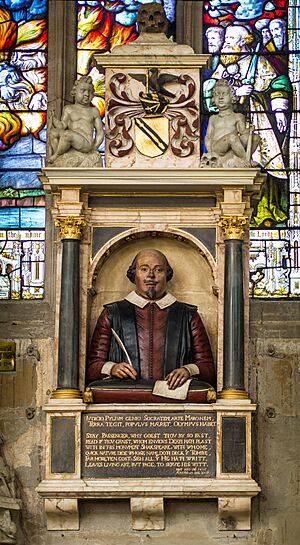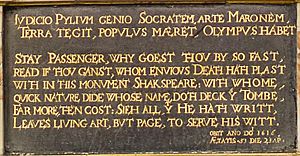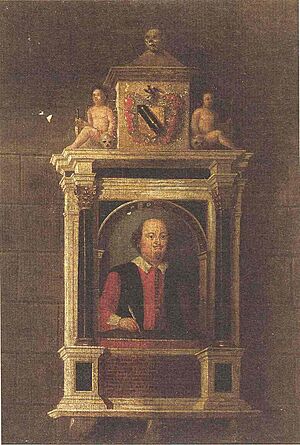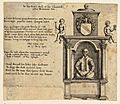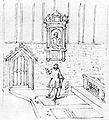Shakespeare's funerary monument facts for kids
The Shakespeare funerary monument is a special memorial for William Shakespeare. You can find it inside Holy Trinity Church in Stratford-upon-Avon. This is the same church where Shakespeare was baptized as a baby and where he was buried after he died. He was laid to rest in the chancel (the area near the altar) just two days after his death.
The monument is made of light blue limestone and was carved by a sculptor named Gerard Johnson. It's placed on the north wall of the chancel. The main part of the monument shows a half-figure of Shakespeare. He's holding a quill pen in one hand and a piece of paper resting on a cushion in the other. This style of monument was popular in the 1600s, especially for important people like religious leaders or scholars.
Shakespeare's statue is wearing a buttoned doublet (a type of jacket) and a loose gown. Originally, the doublet was probably bright red, the gown black, his eyes hazel, and his hair and beard reddish-brown. Over the years, the monument has been repainted many times, and in 1793, it was painted completely white. This statue is one of only two pictures that people believe truly show what William Shakespeare looked like.
At the very top of the monument, there's a shield with Shakespeare's family coat of arms. On each side of the shield, there's a statue of a figure. One figure represents hard work and holds a spade. The other figure represents rest and holds an upside-down torch and a skull.
The monument also has two black, shiny marble columns that hold up the top part. The small angel-like figures (called putti) and the skull are made of sandstone. The tops and bottoms of the columns are made of gilded (gold-covered) sandstone. The decorative parts above the columns were originally made of white alabaster with red veins, but they were replaced with white marble in 1749. The statue of Shakespeare and the cushion are carved from one piece of bluish Cotswold limestone. The dark panels are made of a stone called touchstone.
We don't know the exact date the monument was put up, but it was definitely before 1623. That year, the first collection of Shakespeare's plays, called the First Folio, was published. In this book, there's a poem by Leonard Digges that mentions "thy Stratford moniment" (your Stratford monument). The monument was fixed up in 1748–49 and has been repainted several times since then.
What the Monument Says
Below the statue, there's an epitaph (a short text honoring a dead person) written in Latin and a poem in English.
The Latin epitaph says:
IVDICIO PYLIVM, GENIO SOCRATEM, ARTE MARONEM,
TERRA TEGIT, POPVLVS MÆRET, OLYMPVS HABET
This means: "A Pylian in judgment, a Socrates in genius, a Maro in art." This compares Shakespeare to Nestor, a wise king from Greek stories, to the Greek philosopher Socrates, and to the Roman poet Virgil (whose last name was Maro). The second line means: "The earth buries him, the people mourn him, Olympus possesses him." This refers to Mount Olympus, which was believed to be the home of the Greek gods.
The English poem says:
STAY PASSENGER, WHY GOEST THOV BY SO FAST,
READ IF THOV CANST, WHOM ENVIOVS DEATH HATH PLAST
WITH IN THIS MONVMENT SHAKSPEARE: WITH WHOME,
QVICK NATVRE DIDE: WHOSE NAME, DOTH DECK YS TOMBE,
FAR MORE, THEN COST: SIEH ALL, YT HE HATH WRITT,
LEAVES LIVING ART, BVT PAGE, TO SERVE HIS WITT.
Here's what it means in more modern English:
Stay Passenger, why goest thou by so fast?
Read if thou canst, whom envious Death hath plast
Within this monument Shakspeare: with whom
Quick nature died: whose name doth deck this tomb
Far more than cost: sith [since] all that he hath writ
Leaves living art, but page to serve his wit.
This poem asks anyone passing by to stop and read about Shakespeare. It says that when Shakespeare died, "quick nature died" with him, meaning his amazing talent for writing. It also suggests that his name makes the monument much more valuable than any expensive materials used to build it. The last lines are a bit tricky, but they seem to mean that Shakespeare's writings are so great that other art forms are just like servants to his genius.
Below the poem, in smaller letters, it says when Shakespeare died in abbreviated Latin: "died the year of the Lord 1616, in his 53rd year, on 23 April."
OBIIT AŃO DOI 1616
ÆTATIS٠53 DIE 23 APR.
History of the Monument
The monument was first shown and talked about in a book called Antiquities of Warwickshire by Sir William Dugdale in 1656. Dugdale wrote that Stratford was where "our late famous Poet Will. Shakespere" was born and buried. The picture in the book was likely made by Wenceslaus Hollar from a sketch Dugdale drew around 1649. This sketch was probably supported by Shakespeare's granddaughter, Elizabeth Barnard, who was his last living descendant.
Interestingly, these early pictures of the monument look a bit different from how it looks today. For example, Shakespeare isn't shown holding a quill or paper, and the cushion looks like it's pressed against his body. One art critic even joked that it looked like Shakespeare was hugging the cushion because of stomach pains!
In 1725, a new edition of Shakespeare's works was published by Alexander Pope. This book included a more accurate picture of the monument, drawn by George Vertue in 1723.
The monument was repaired and cleaned in 1748–49. To help pay for this, a local school master named Joseph Greene organized the first known performance of a Shakespeare play in Stratford. A theater company performed Othello in the Town Hall, and all the money from ticket sales went to the restoration.
After the restoration, Greene wrote that the statue of Shakespeare was taken down to be cleaned. He noted that the statue and cushion were carved from a single piece of limestone. He also said that they tried to keep the monument as close to its original look as possible. They only changed the material of some decorative parts from alabaster to marble. They also fixed any broken pieces and brought back the original colors and gold details. John Hall, an artist hired for the restoration, even painted a picture of the monument before he started working on it.
Over the years, Shakespeare's quill pen has been stolen and replaced many times. The paint on the monument has also been refreshed. In 1793, a Shakespeare scholar named Edmond Malone convinced the church to paint the monument entirely white. This was a popular style at the time. However, in 1861, the white paint was removed, and the monument was repainted in the original colors that were found underneath.
In 1973, some people broke into the church and tried to chip away at the inscription on the monument. The police thought they might have been looking for valuable Shakespeare manuscripts, which were rumored to be hidden inside the monument. Luckily, the statue only had "very slight damage."
Gallery
-
Sketch by William Dugdale, made around 1649, used for an engraving in his book.
-
An engraving for Nicholas Rowe's 1709 book of Shakespeare's works.
See also
 In Spanish: Monumento funerario de Shakespeare para niños
In Spanish: Monumento funerario de Shakespeare para niños


